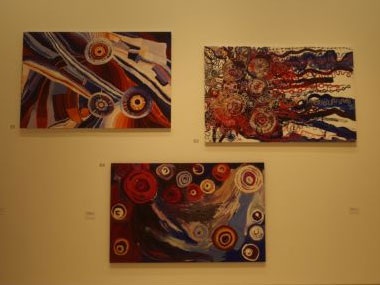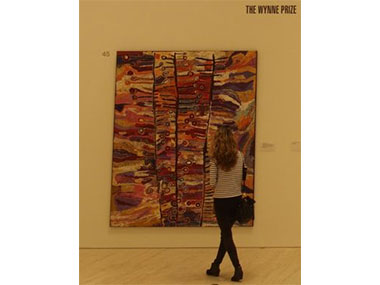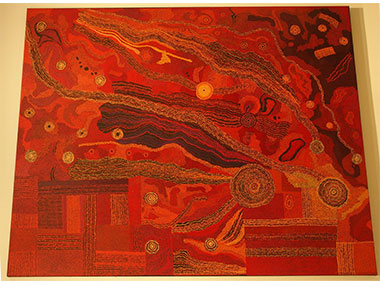APY ART DOMINATES THE WYNNE

The Barbara Moore Effect - artworks by (l to r) Beryl Jimmy, Barbara Moore and Yaritji Young look stunning on the walls of the AGNSW
Posted by Jeremy Eccles | 20.07.17
Gallery: Art Gallery of NSW
Dates:
29.07.17
: 22.10.17
After last year's triumphant win by the five Ken Sisters from Amata in the Art Gallery of NSW's annual Wynne Prize for landscape painting, artists across the Lands have got hugely competitive this year! Nine major canvases by them have been selected by the Gallery's Trustees to hang in the competition, and they're so strong that they've displaced the normally headlining Archibald Prize (for portraiture) from its central position in the hang. Not only that, but for the second time (I believe), an abstract APY canvas by Tjungkara Ken based on the same Seven Sisters Dreaming imagery has been accepted as a self-portrait.
Not surprising, really when, last year, Natalie O’Connor, Manager of Tjala Arts could explain that the Seven Sisters story is not just about stars in the sky but about family: “In the Seven Sisters story, the elder sisters protect and teach the younger sisters and keep them from falling for the tricks of Watti Niru. The women say this is how family works in Anangu culture – the elder women teach the young women”.
It's pretty overwhelming entering this beautifully hung room – so much so that I was forced to ask Indigenous curator Cara Pinchbeck whether she had made the selection this year rather than the Gallery's Trustees? She reassured me that the Trustees had done their job without any help, and they were obviously equally overwhelmed by the riches of the APY Lands – which, incidentally, enjoy a rather less overwhelming show of art greeting visitors in the huge main entrance hall of the Gallery upstairs. “I think it's simply that after the Ken Sisters' win”, Pinchbeck explained, “all the other artists in the region wanted to compete – not only in the strength of their jukurrpas but also in the size of their canvases”.
A few things to note: one wall seems to reveal what might be called the Barbara Moore effect – three fine canvases, including one by Moore, all sharing her bold brush-strokes and colouration. Secondly, the sister effect – anything the Ken Sisters can do, the Pumanis – Betty and Ngupulya - can do too with their shared Antara Jukurrpa (Witchetty Grub Dreaming). Third, great art from the deserts isn't restricted to the familiar names – I'd not heard of Manyitjanu Lennon or Mona Mitakiki before; but their works are as big and bold as anyone's. And finally, the power of the Anangu women is apparent – just one bloke, Ray Ken, gets a guernsey.
Mind you, I'd put my money on Wawiriya Burton if asked - her Ngayuku mamaku ngura (my father’s country) minyma mingkiri tjuta (small desert female mice) is a complex ripper, and a clear advance in sheer aesthetics upon an earlier work of her's upstairs.
The APY dominance does have a slightly shadowing effect on the non-APY works hanging in that room – especially Regina Wilson's delicate, multiple woven sun-mat work, oddly entitled Shadows of Shaw. Even Yakultji Napangati's classic Papunya Tula, densely sand-duned work which seemed to me to be marvellously masculine, lost something in the face of three walls of brilliance.
Perhaps sensibly, the two Buku Larrnggay works on wood are in another room! They share one thing in common – a reluctance to deny the arboreal origins of their canvases by leaving a dramatically rent edge to each work, a bark by Nyapanyapa Yunupingu and a larrikitj by Wukun Wanambi. Yunupingu's is a dark work by her sunny standards, and Wanambi's stout tree is covered with his trademark fishes.
Finally, the Wynne tucks in a small Mumu Mike Williams spear work – though it's credited collaboratively to Mumu Mike Williams, Willy Muntjantji Martin and Sammy Dodd. As it hangs from a carved wooden kulata (spear), has land rights messages in Pitjanjatjara painted on recycled postal bags and features several more spears, I suspect Williams was the main man.
Apart from Tjungkara Ken's rich self-portrait – which of the seven stars is she?? - Vincent Namatjira with a toothy self-portrait and Tony Albert are the other Indigenous artists selected in the Archibald Prize. Albert offers yet another self-portrait featuring his all-too familiar “Ashed on” aboriginal-kitsch ashtrays. But the odd Blackfellar gets portrayed – most notably actor Jack Charles (as Charles Darwin, evolved??) who could well win the the big one for TV-artist Ahn Do. Richard Bell is seen most oddly by Sophia Hewson, off with the pixies, or is that Sister Maria from 'The Sound of Music'?
Artist Tony Albert also got to select the unpredictable Sulman Prize show – and a fine job he's done by many a reckoning, given that no one knows what its limitation to “genre painting” actually means! Perhaps Indigenous artists don't know either – for none has been chosen. Though the Chinese-born and based Guan Wei has a few thoughts on Invasion Day.
The results will be known next Friday.
URL: https://www.artgallery.nsw.gov.au/prizes/
Share this:
»  del.icio.us
»
del.icio.us
»  Digg it
»
Digg it
»  reddit
»
reddit
»  Google
»
Google
»  StumbleUpon
»
StumbleUpon
»  Technorati
»
Technorati
»  Facebook
Facebook
Contact Details
Gallery: Art Gallery of NSW
Contact: Cara Pinchbeck - Curator of Aboriginal and Torres Strait Islander Art
Email: artmail@ag.nsw.gov.au
Telephone: +61 2 9225 1700 or 1
Address: Art Gallery Road Sydney Sydney 2000 NSW
Gallery: Art Gallery of NSW
Contact: Cara Pinchbeck - Curator of Aboriginal and Torres Strait Islander Art
Email: artmail@ag.nsw.gov.au
Telephone: +61 2 9225 1700 or 1
Address: Art Gallery Road Sydney Sydney 2000 NSW

Wawiriya Burton's 'Ngayuku mamaku ngura (my father’s country)' holds the attention in the 2017 Wynne Prize in Sydney

Tjungkara Ken's solo work, 'Kungkarangkalpa tjukurpa' (Seven Sisters Dreamng) - a self-portrait - stars in the 2017 Archibald Prize at the Art Gallery of NSW
Where is the exhibition?
Further Research
Gallery: Art Gallery of NSW
Artists: Barbara Moore | Betty Pumani | Ken Sisters | Manyitjanu Lennon | Mona Mitakiki | Mumu Mike Williams | Ngupulya Pumani | Nyapanyapa Yunupingu | Ray Ken | Regina Wilson | Sammy Dodd | Tjungkara Ken | Tony Albert | Vincent Namatjira | Wawiriya Burton | Willy Muntjantji Martin | Wukun Wanambi | Yakultji Napangati
News Tags: AGNSW | APY Lands | Archibald Prize | Cara Pinchbeck | Jeremy Eccles | Ken Sisters | Sulman Prize | Wynne Prize
News Categories: Art Prize | Australia | Blog | Exhibition | Industry | News
Exhibition Archive
- 10.10.17 | TARNANTHI 2017
- 11.08.17 | Natsiaas 2017
- 20.07.17 | APY ART DOMINATES THE WYNNE
- 17.07.17 | Anangu Artist Wins $100,000 Prize
- 14.07.17 | The End of AAMU
- 11.07.17 | ART ACROSS THE COUNTRY
- 11.07.17 | TARNANTHI IN OCTOBER
- 05.07.17 | TJUNGUṈUTJA - from having come together
- 13.06.17 | Ghost-Nets Straddle the World
- 07.06.17 | Grayson Perry Going Indigenous?
- 05.06.17 | Barks Bigger than Ben Hur
- 27.05.17 | NGA QUINQUENNIAL 2017
- 21.05.17 | Blak Douglas Finds Home at the NGA
- 21.05.17 | BRIAN ROBINSON WINS HAZELHURST WOP
- 18.05.17 | PARRTJIMA 2.0
Advertising

